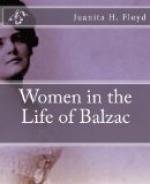A few years before her death, La Femme abandonnee was dedicated:
“To her Grace the Duchesse d’Abrantes,
“from her devoted servant,
“HONORE DE BALZAC.”
If such was the role played by Balzac in the life of Madame d’Abrantes, how is she reflected in the Comedie humaine?
It is a well known fact that Balzac not only borrowed names from living people, but that he portrayed the features, incidents and peculiarities of those with whom he was closely associated. In the Avant-propos de la Comedie humaine, he writes: “In composing types by putting together traits of homogeneous natures, I might perhaps attain to the writing of that history forgotten by so many historians,—the history of manners.”
In fact, he too might have said: “I take my property wherever I find it;” accordingly one would naturally look for characteristics of Madame d’Abrantes in his earlier works.
According to M. Joseph Turquain, Mademoiselle des Touches, in Beatrix, generally understood to be George Sand, has also some of the characteristics of Madame d’Abrantes. Balzac describes Mademoiselle des Touches as being past forty and un peu homme, which reminds one that the Countess Dash describes Madame d’Abrantes as being rather masculine, with an organe de rogome, and a virago when past forty. Calyste became enamored of Beatrix after having loved Mademoiselle des Touches, while Balzac became infatuated with Madame de Castries after having been in love with Madame d’Abrantes, in each case, the blonde after the brunette.
Mademoiselle Josephine, the elder and beloved daughter of Madame d’Abrantes, entered the Convent of the Sisters of Charity of Saint-Vincent de Paul, contrary to the desires of her mother. In writing to the Duchess (1831), Balzac asks that Sister Josephine may not forget him in her prayers, for he is remembering her in his books. Balzac may have had her in mind a few years later when he said of Mademoiselle de Mortsauf in Le Lys dans la Vallee: “The girl’s clear sight had, though only of late, seen to the bottom of her mother’s heart. . . .” for Mademoiselle Josephine entered the convent for various reasons, one being in order to relieve the financial strain and make marriage possible for her younger sister, another perhaps being to atone for the secret she probably suspected in the heart of her mother, and which she felt was not complimentary to the memory of her father. And also, in La Recherche de l’Absolu: “There comes a moment, in the inner life of families, when the children become, either voluntarily or involuntarily, the judges of their parents.”
In writing the introduction to the Physiologie du Mariage, Balzac states that here he is merely the humble secretary of two women. He is doubtless referring to Madame d’Abrantes as one of the two when he says:




